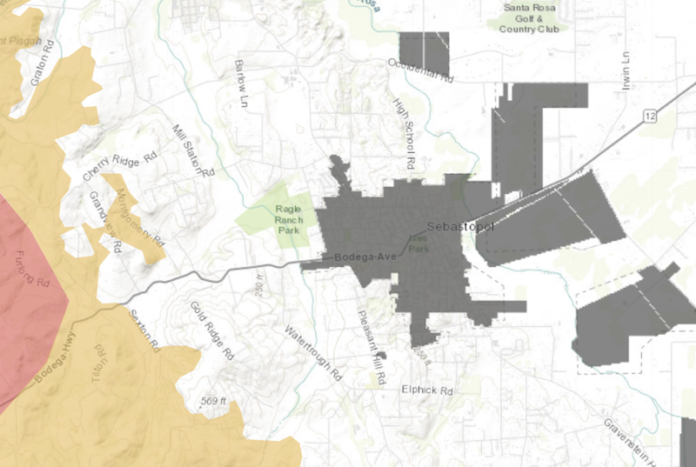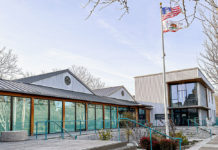
As another fire season fit to raise hell begins, representatives from the Pacific Gas & Electric Company (PG&E) presented its community wildfire program and public safety power shut off updates for the year at the May 18 Sebastopol City Council meeting.
Melinda Rivera took the lead as a PG&E’s local public affairs representative for Sonoma and Lake counties. She introduced the California Public Utilities Commission (CPUC) map created with CalFire and the U.S. Forest Service to show what areas in the state are most vulnerable to wildfires, searchable here.
The CPUC map that PG&E uses to plan preventative work labels regions as Tier 2 for “elevated” fire risk and Tier 3 for “extreme” risk, Rivera said.
Sebastopol appears untiered, with its closest high fire threat zone to the west, a Tier 2 area running north and south along Sexton Road and Gentry Lane, according to PG&E public safety specialist Mike Wilson.
As of March 2021, the online CPUC FireMap shows Bodega Highway entering the Tier 2 zone past Sexton Road, knuckles of elevated risk creeping to Montgomery Road and toward Gold Ridge Road. Extreme fire risk rules farther west, swallowing Occidental and Camp Meeker.
Vice Mayor Sarah Glade Gurney requested information on how the PG&E grid casts over the city limits, saying the city and its proactive residents could prime for protection.
Rivera said she would need to consult with others from PG&E about options for a grid flyover, but Austin Sharp, who Rivera said was the division leadership team leader for the county, said they would share the most information they could given some of the system was confidential.
Public safety specialist David Hotchkiss said the transmission line enters the Molino substation north of Sebastopol, above Occidental Road, with two circuits “feeding the city limits proper” and west and southwest zones. “And that feeds out into the Tier 2 area that Mike Wilson spoke about earlier,” he added.
PG&E’s community wildfire safety plans
The community wildfire safety program seeks to lower wildfire risks and public safety power shutoff (PSPS) impacts in multiple ways, with specific goals for 2021.
This year, PG&E is working to harden the lines, meaning more fortified poles, covered lines and possibly “targeted undergrounding,” and strengthen 180 electric circuit miles, according to Rivera’s presentation.
She said the community wildfire safety program involves enhanced vegetation management for trees and plant life near power lines, to ideally surpass state standards. PG&E aims to treat vegetation along 1,800 electric circuit miles more jeopardized by fire danger, Rivera said.
PG&E also aims to situate more than 275 sectionalizing devices and transmission switches that break up the electric grid to lower the magnitude of PSPS events and number of people affected, she said.
Further, the gas and electric company intends to install 300 more weather stations and 135 more high-definition cameras this year for “tracking weather conditions and monitoring for wildfires,” according to Rivera. She said the program includes plans for five-day forecast data for better weather modeling.
Rivera introduced new services in 2021, like customer service notifications in 16 languages, more ADA-accessible Community Resource Centers (CRC) for “basic power needs and up-to-date information” during PSPS events, as stated in her slides.
The services include supplying about 5,000 batteries for “all-low-income medical baseline customers who live in high fire threat areas,” meal replacement options and growing collaboration with community-based organizations, per the presentation.
PG&E is partnering with the California Foundation for Independent Living Centers “to enable qualifying customers who use electrical medical devices to access backup portable batteries through a grant or lease to own or a financial loan application,” Rivera said.
Further, PG&E is starting to offer “Address Alerts” this year, “which allow both customers and non-customers to sign up to receive PSPS alerts about any address that they choose,” such as a workplace, school or loved one’s home.
“And then this year PG&E is also piloting a program to provide generator rebates. This is for customers who depend on a well-water pump and who live in a high-fire threat area, so they can be eligible for a rebate by purchasing a qualified portable power generator,” she added.
How customers will be alerted during public safety power shutoffs
According to Rivera, PG&E may choose to power off in risky conditions with low humidity, parched vegetation that might contact a power line, or winds forecasted to blow over 20 miles an hour and gust over 30 to 40 miles per hour.
A PSPS event can also be activated when the National Weather Service calls for a red flag warning or trees reach high enough to hit the lines, she said.
Rivera said customers can expect to be alerted two days before the shutdown during a PSPS watch mode, the day before the power turns off in watch mode, right before the power goes off in a warning mode, once daily during the PSPS event and then when the power is turned back on.
“So, customers can receive updates through automated calls, texts and emails and we encourage everyone to review the contact information that PG&E has on file by visiting pge.com/mywildfirealerts,” she said, in addition to the new Address Alerts service.
Requesting resources for Sebastopol
Mayor Una Glass and Councilmember Diana Rich both asked about a potential community resource center stationed in Sebastopol.
Rivera said Sebastopol and PG&E don’t have a contract for a CRC in the city and the closest ones would be in Santa Rosa, Rohnert Park or more down river, with sites in the Guerneville area and out to the coast.
The emergency management department recommends locations where a shutoff is most likely to impact a community, striking mostly in east Sonoma County last year, according to Rivera.
Glass asked what the city could do to request a CRC in Sebastopol given that it may share an electric grid with a Tier 2 area, likely to lose power in an event but safer from fire than its neighboring regions.
“We’re at the intersection of two highways, so it would seem to me that it would make sense that we’d have a CRC here,” she said, whereas the locations Rivera listed lie on the other side of “clogged highways.”
Community member Kyle Falbo said he wanted PG&E to reassess its metrics on Sebastopol’s risk status to consider that the small city of about 8,000 supports tens of thousands of people who may live in the surrounding higher risk areas.
“I would encourage PG&E to reevaluate their metrics regarding the resources and maintenance allocated to the city of Sebastopol due to the resource, traffic and evacuation route hub that Sebastopol currently exists as,” he said.
Previously, Rivera responded to Glass that she would speak with the city manager and if there’s no current contract with Sebastopol, she could explore potential for a CRC micro-site. “These kind of operate out of sprinter vans for communities where something has come up at the last minute.”
“The short answer to your question is really the cities can work with the department of emergency management for the county of Sonoma. We really do go based on their feedback and I know that they look at where historically the impacts have been for the PSPS events,” she said.
Editor’s note: This article has been edited to more accurately reflect Melinda Rivera’s statement that the closest CRCs to Sebastopol would be in Santa Rosa, Rohnert Park or more down river, in addition to sites in the Guerneville area and out to the coast.







